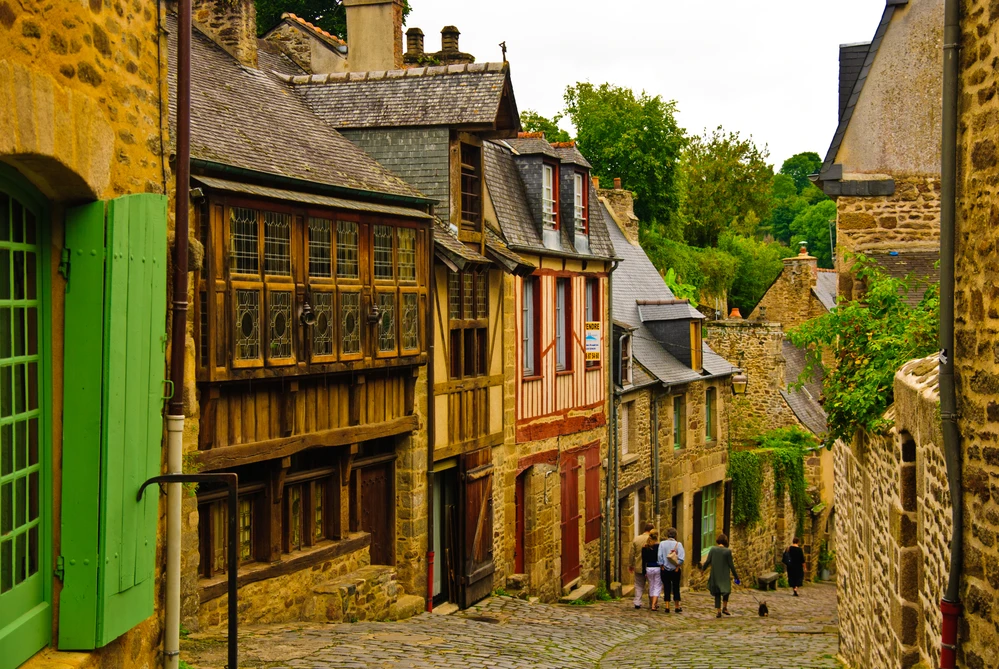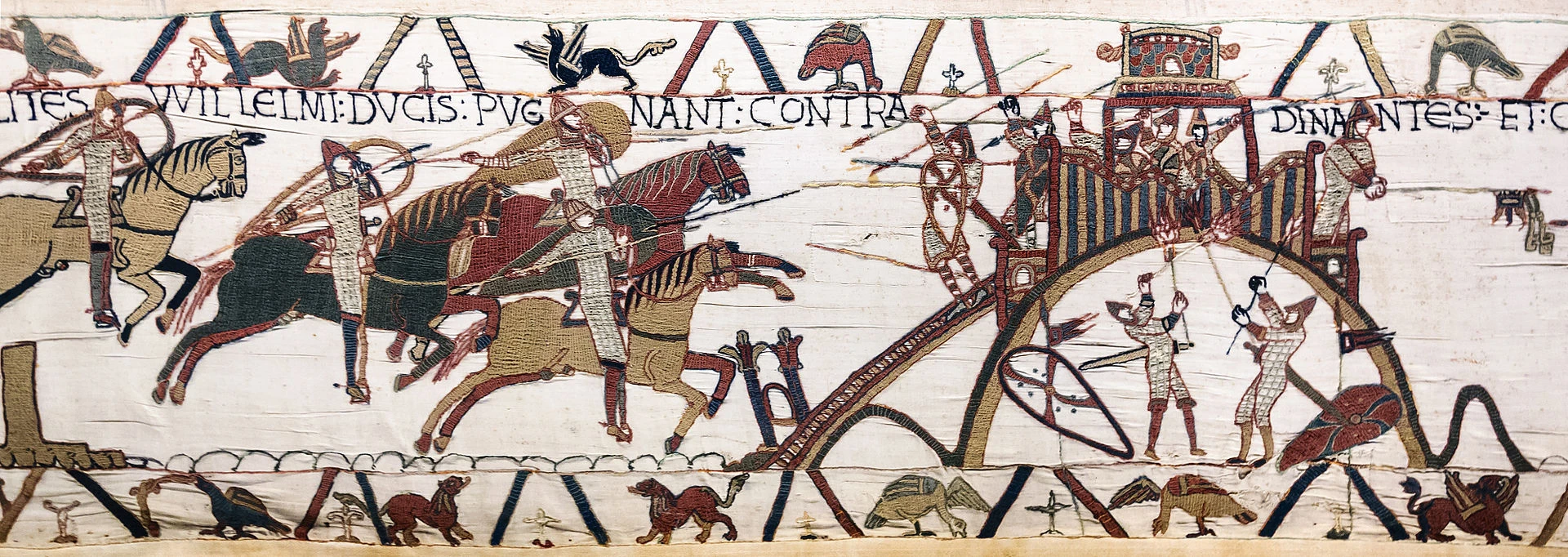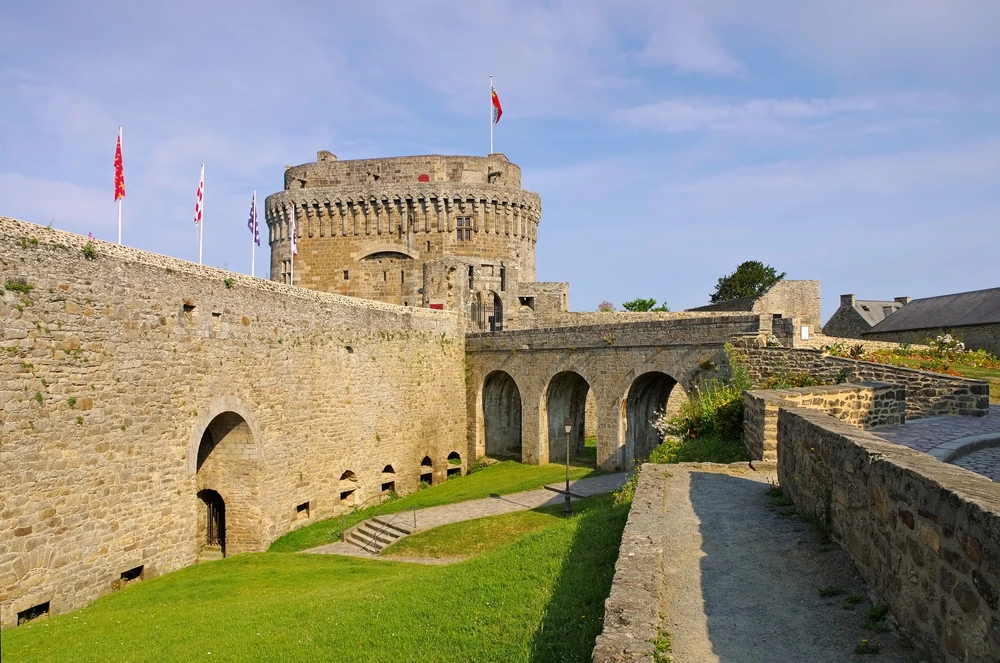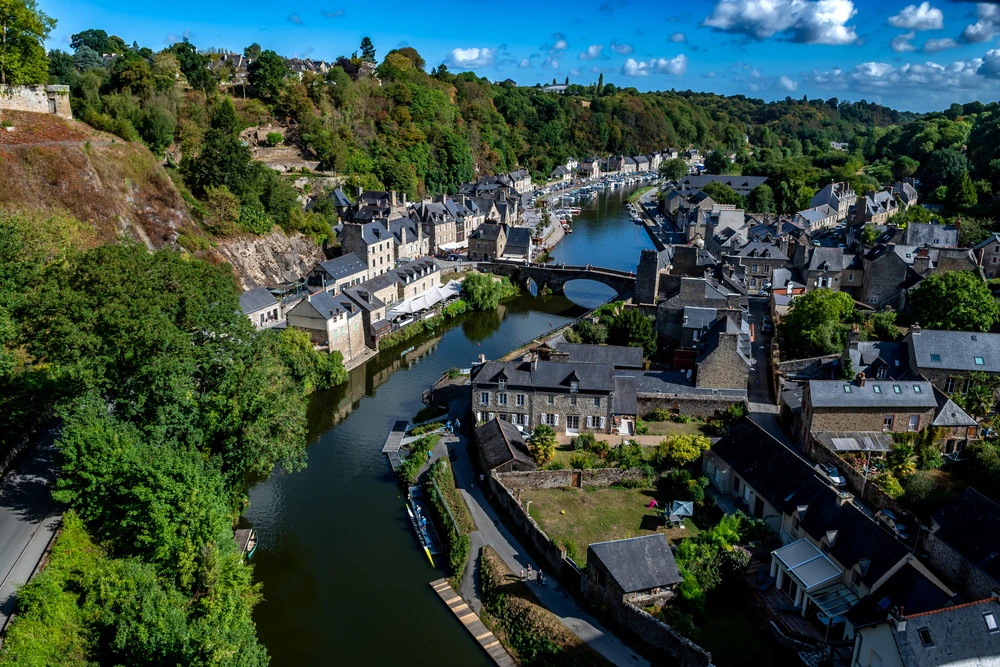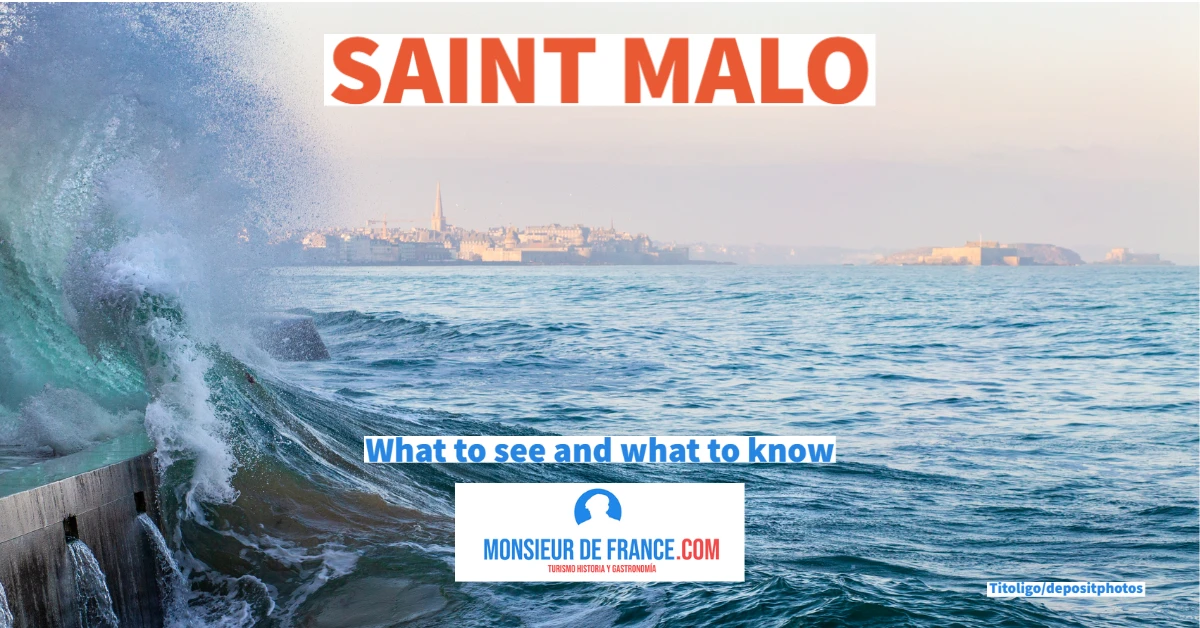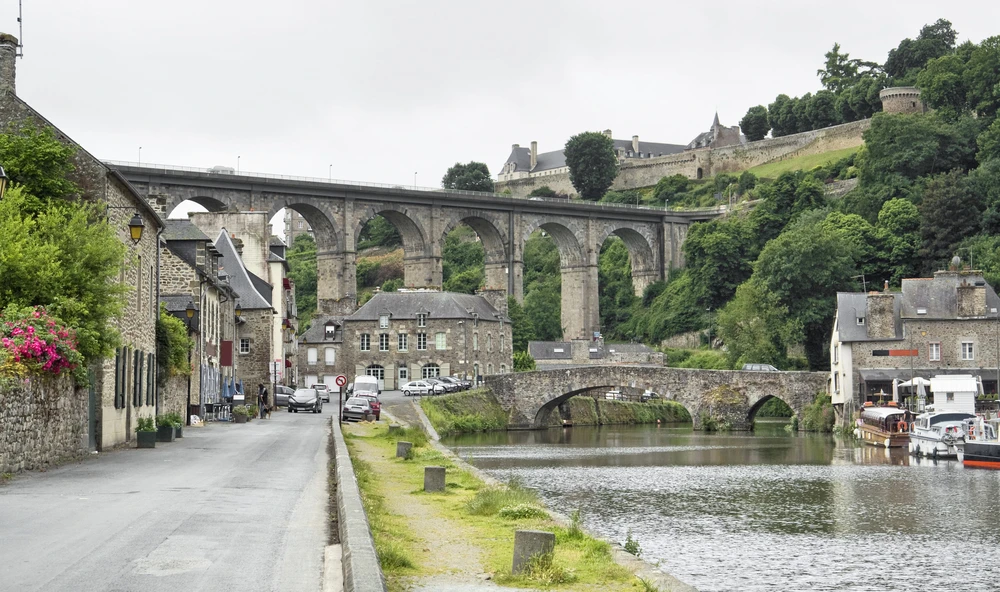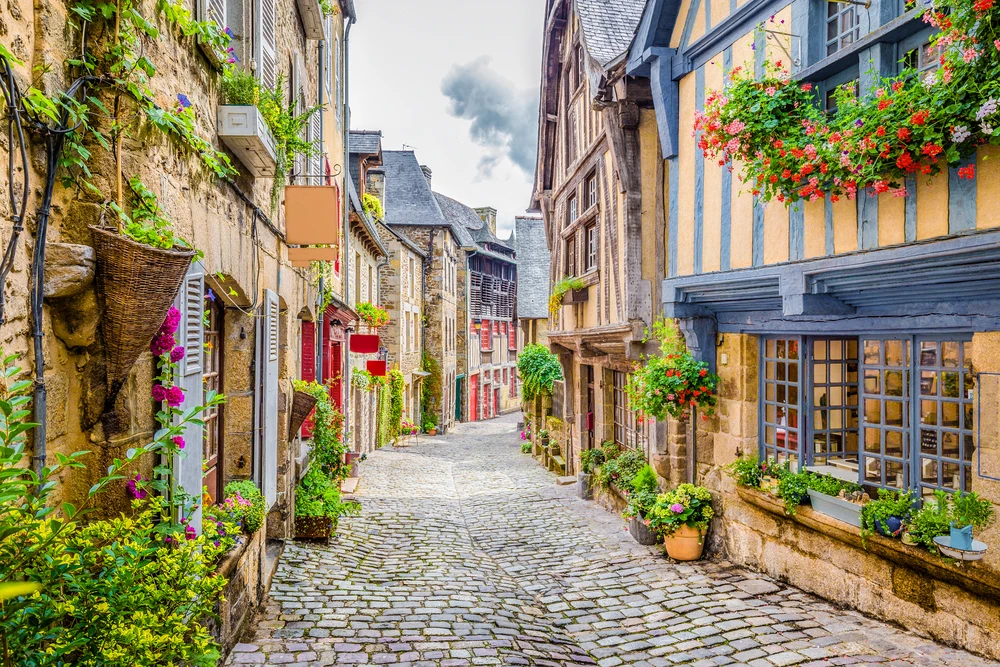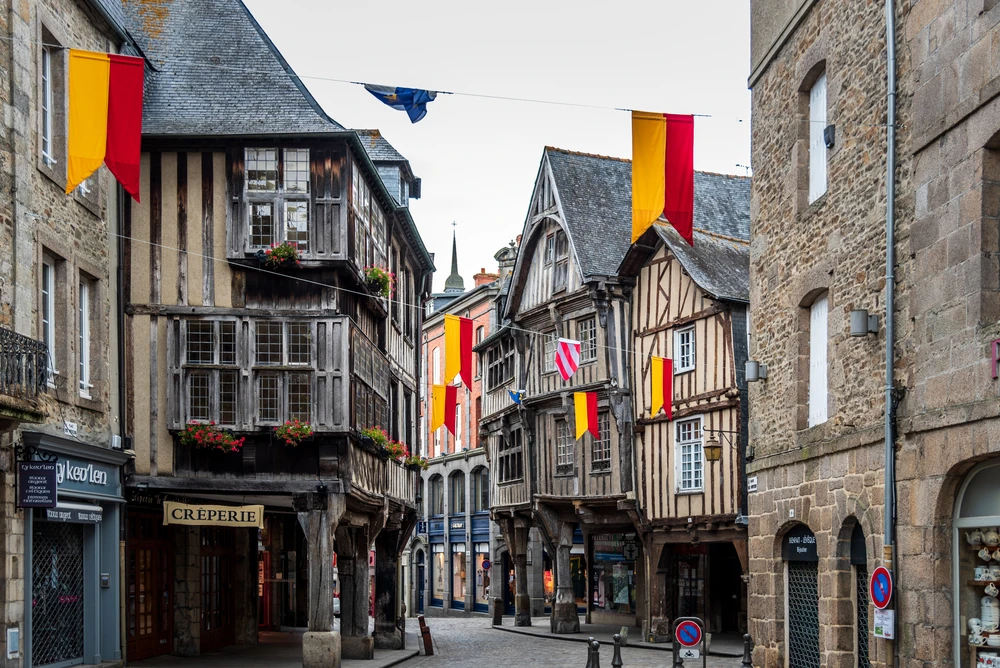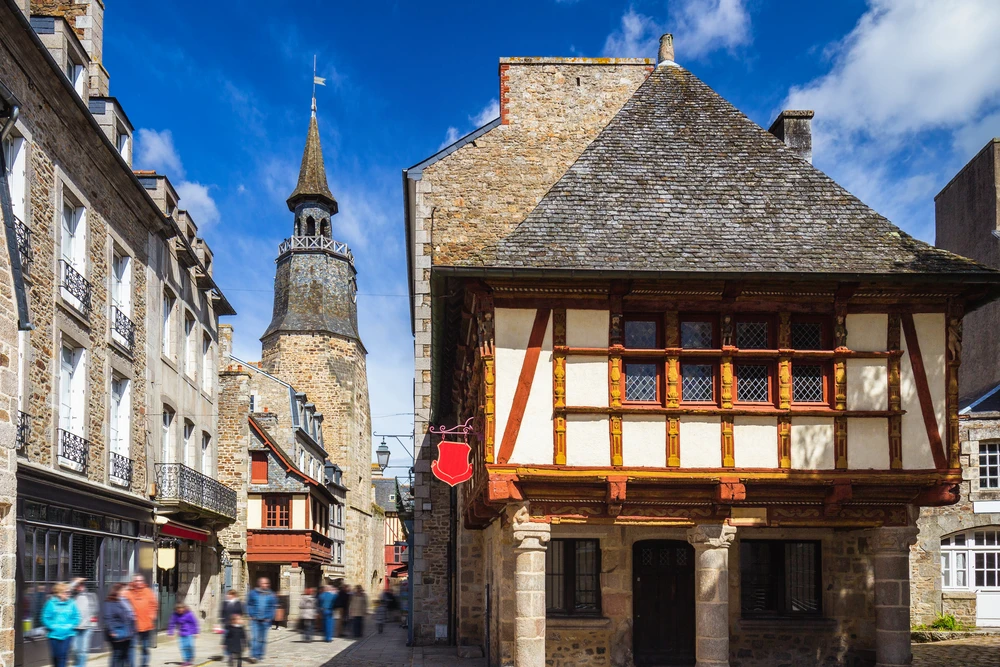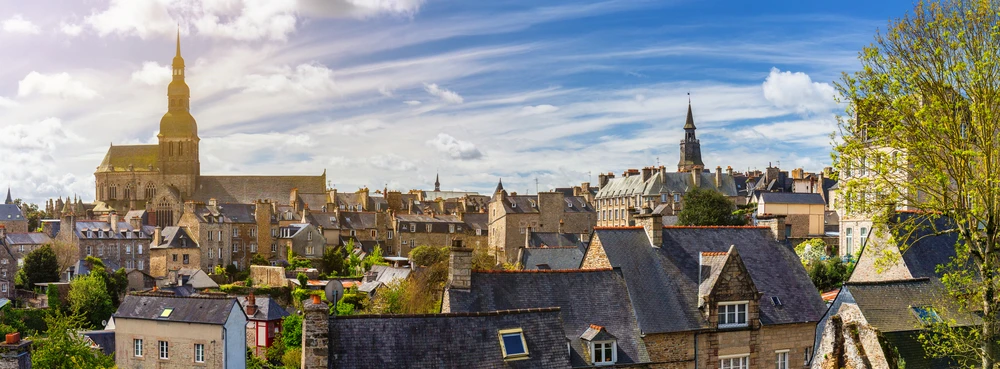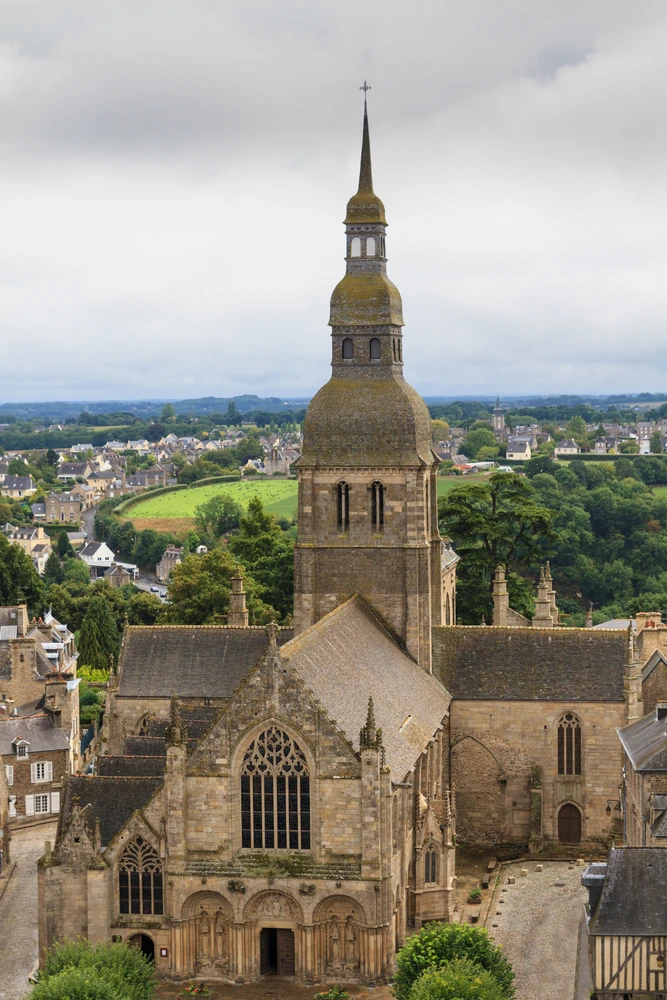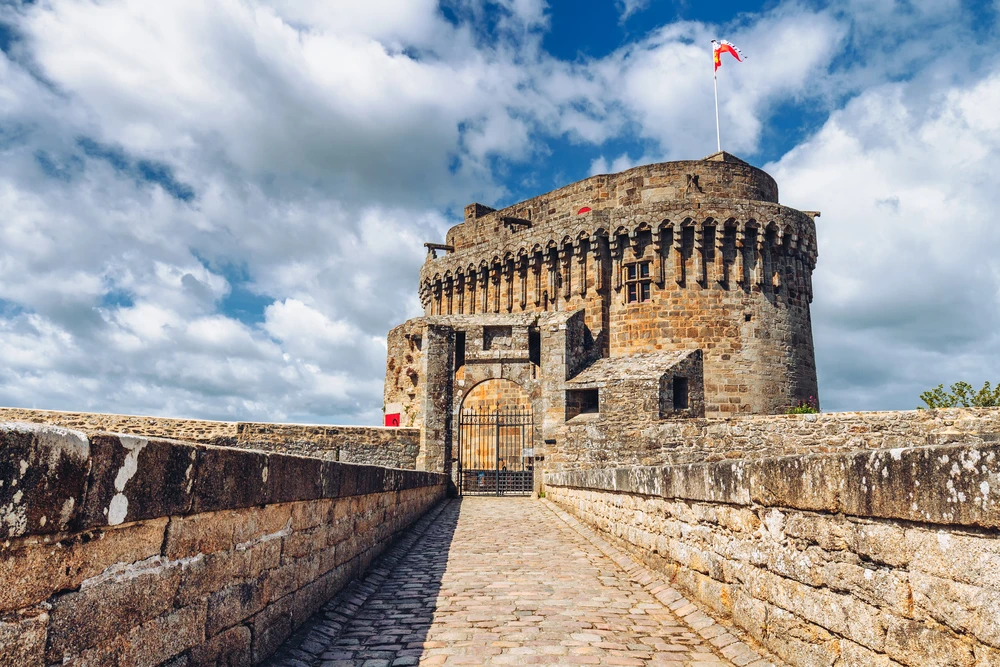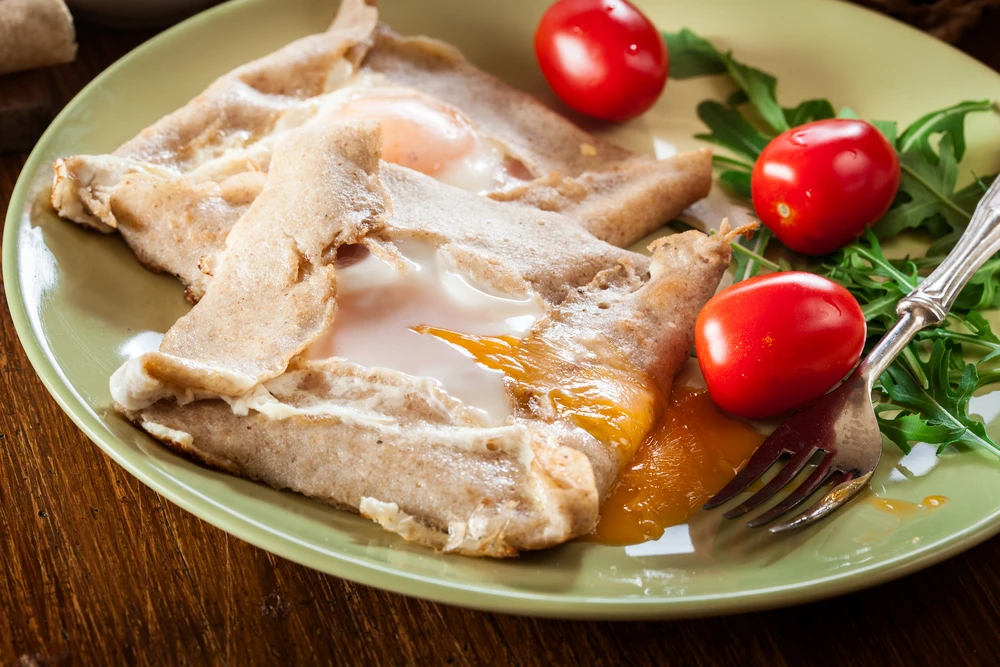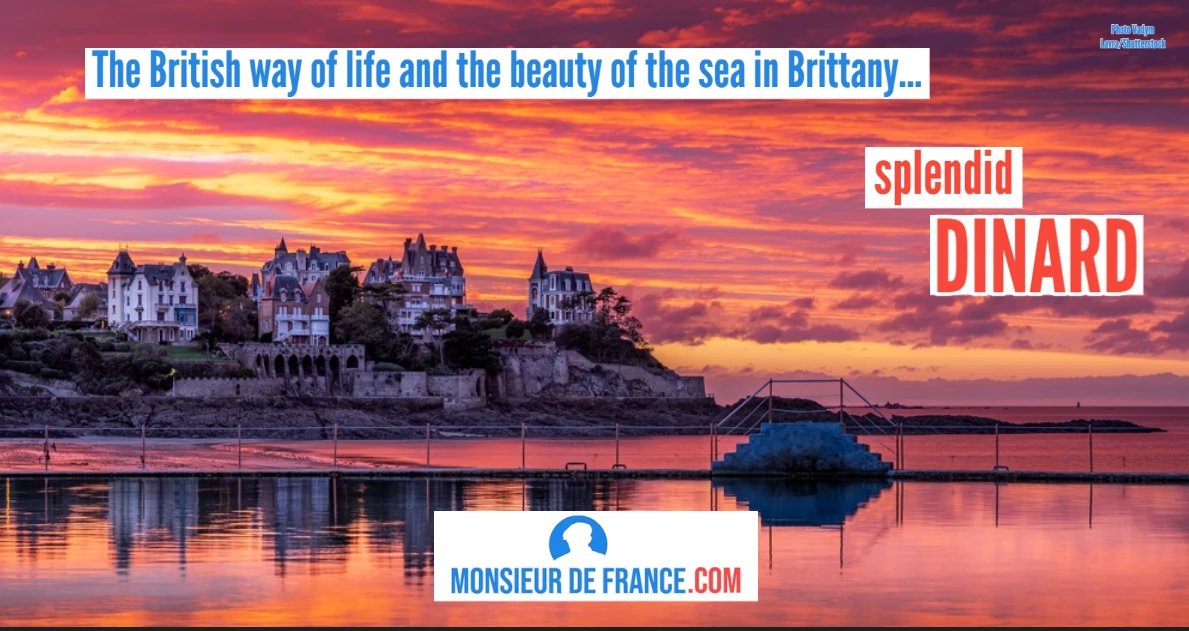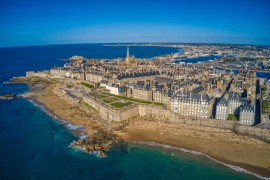There may be translation errors. Our translator has had too much Breton cider. His mom takes his place...
First, a little history
Dinan's charm lies in its old houses / Photo chosen by monsieurdefrance.Com via depositphotos.
In the Middle Ages, Dinan came into its own
Dinan depicted on the Bayeux tâpisserie. Conan, Duke of Brittany, is defeated by William the Conqueror. Photo chosen by monsieurdefrance.com: By Myrabella - Own work, Public domain, https://commons.wikimedia.org/w/index.php?curid=25390882 Wikipedia.
This has always been a strategic location, as it lies at a great height (75 m difference in height between the river and the town) and on the banks of a river. Many historians believe that the name Dinan comes from "Dun", the Gallic word for fortress, meaning "little fortress". Dinan's importance really took off in the Middle Ages. It was besieged by William the Conqueror in 1064 (2 years before the conquest of England), which earned it a place on the Bayeux tapestry. From 1283 onwards, the Dukes of Brittany turned the town into a veritable stronghold . Stone ramparts (of which more than 2,500 meters remain) were built, flanked by defensive towers and gates (the Jerzual gate still stands). The château was built from 1380 onwards, as the residence of the Dukes of Brittany, with all the princely comforts of the time: banqueting hall, huge kitchens, ceremonial chambers, chapel... The town of Dinan was besieged by the English during the 100 Years' War, and it was a local hero, Bertrand du GUESCLIN (1320-1380), whose memory lives on today, who saved the town. In 1488, with the defeat of the Duchy of Brittany and its annexation to France, Dinan ceased to be an important stronghold , although it continued to prosper.
The enormous Château de Dinan (14th century). Image chosen by monsieurdefrance.com: Kassandra2 via depositphotos.
A commercial and religious city
After the Benedictines, who have been present since the High Middle Ages, the Cordeliers and Jacobins dominate the city, as do the Ursulines, Capuchins, Benedictines and Poor Clares .... And the town is located on a strategic commercial axis, since it lies along the Rance river , and goods pass through the Dinan quays, under the town, before going to the port of Saint Malo, still an international port today, but by far the leading export port in Western France throughout the 17th, 18th and 19th centuries. During the French Revolution, Dinan became sub-prefecture of the newly created "côtes du Nord" department in 1790 (the name was fortunately changed to "côtes d'Armor" in 1990).
Dinan harbor seen from the viaduct. The river is called the Rance. Image chosen by monsieurdefrance.com: grafxart via depositphotos.
And touristy for a long time:
The 19th century saw the town continue to trade thanks to the road (from 1852 and the construction of the viaduct) and the train (1879). It also saw the arrival of its first tourists, English of course, including Lawrence of Arabia, who wrote of Dinan in a letter, "I have fallen in love with the Rance". It was here, too, that he developed a passion for the local cider, which was far superior to that of the English. Spared by the 1944 bombing raids that ravaged Saint Malo, the center of Dinan has retained a look that hasn't changed much since the 19th century, or even since the Middle Ages, and that's exactly what we like...
Must-sees in Dinan
The port
The port of Dinan with the Rance river, the old bridge, the viaduct, and the town above on the right. Photo chosen by monsieurdefrance.com: Prill via depositphotos.com
I always start here (even if parking is a bit tricky). You walk along the river Rance. Thereare lots of nice little restaurants and crêperies where you can sample local specialities like the famous Breton galettes. In the distance, you can see the viaduct, which dominates the valley from its 40-metre height (it dates back to 1852) and links the two banks of the Rance, allowing trade to pass better than the old bridge, just below, which dates back to the 15th century (there was already a bridge in the 10th century) and was for a long time one of the few possible places to cross the river, which also explains Dinan's success over several centuries.I like to stop off at Le Zag, a pizzeria next to the old bridge, where the terrace is very pleasant. The port made Dinan's fortune. It was here that linen and hemp from Brittany were sold to equip ships, and spices were bought.
Rue du Jerzual
Rue du Jerzual in Dinan. Photo chosen by monsieurdefrance.com: pandionhiatus3 via depositphotos
There's something for everyone, from the Middle Ages and knights to Harry Potter's "chemin de traverse". A narrow street lined with half-timbered houses (walls of wood and wattle and daub) and, above all, very steep (hang on for the climb), a little slippery when it's raining, which leads up from the port to the town of Dinan, passing under the 14th-century Porte du Jerzual. Turning right after the gate, you can walk along the city walls. The area is often in bloom in summer, adding to its charm. The old houses are a reminder of the way trade was done in the Middle Ages, with their storefronts where trays could be hung to display merchandise. Nowadays, you'll find many craftsmen and women.
Dinan town center
The streets of downtown Dinan with their typical houses. Take the time to get lost on purpose. Photo chosen by monsieurdefrance.com: JJFarquitectos via depositphotos.
Rue de l'horloge, Place des merciers, Place des cordeliers, Dinan's town center is magnificent. It alternates between very old half-timbered houses (with an overhang to shelter from the rain, which is not uncommon in this part of Brittany) and stone houses or even private mansions. You're bound to find a little restaurant if you want to take a break. Not to be missed: the market under the Halles, the astonishing Tour de l'Horloge (Clock Tower), the town's belfry, erected in the 15th century by the bourgeoisie of Dinan as a reminder of their importance in the face of the power of the Duke of Brittany and the Church. You can climb the tower (which is 45 meters high) for 4 euros (price 2023). For opening times, see the end of the page. I've provided all the links to tourist sites, but note that in summer it's open morning and afternoon, and in winter only in the afternoon. I've fallen in love with the "Mystères et bonbonnière" confectionery in the rue de la poissonnerie. In addition to the delicacies, you'll discover a world mixing Breton fairies and legends with Harry Potter. Kids love it.
The 45-meter high clock tower dominates the historic center. Photo chosen by monsieurdefrance.com: DaLiu via dépositphotos
Dinan's churches
On the left, the bell tower of Dinan's Basilique Saint Sauveur, on the right, the clock tower. Photo chosen by monsieurdefrance.com YayImages via depositphotos.
There are 3 must-see religious monuments in Dinan. The Saint-Sauveur basilica crowns the town. The oldest parts are over 900 years old. Most of it dates from the 15th century and was never completed. The interior is richly furnished under the wooden vault, and I recommend you take a look at the column capitals. They are quite original. For example, there's an astonishing representation of lust or pride, a pelican...
The high altar at Saint Sauveur church in Dinan / Photo chosen by monsieurdefrance.com: MB-Photos via depositphotos.
Inside, you'll find the cenotaph of Bertrand du Guesclin's heart, stained-glass windows dating back to the 12th century and a 17th-century high altar. At the rear of the church, you'll find a lovely English garden (formerly a cemetery).
The facade of the Saint Sauveur basilica in Dinan. Photo chosen by monsieurdefrance.com: Berti123 via depositphotos
The other major church is Saint Malo. Located on rue de la boulangerie, it is the town's oldest church, dating back to the 11th century. The church is in the flamboyant Gothic style, and the stained-glass windows are particularly beautiful. The stone bell tower was never completed, so a wooden and slate steeple was added. To finish your tour of religious buildings, make a detour to rue de la Laînerie to see the façade of the Cordeliers convent, whose porch is typical of the Middle Ages.
The Church Saint Malo de Dinan / Photo chosen by monsieurdefrance.com: BorisB17 via depositphotos.com
Dinan castle
This majestic structure dominates the valley, standing 30 metres high and rising 70 metres from the valley. Built from 1380 onwards by order of Duke Jean IV of Brittany to remind the people of Dinan who was the master, it is also known as the Château de la Duchesse Anne (Anne of Brittany). It has 5 levels (formerly topped by a 6th slate level) and can be visited from the inside of a princely palace from the Middle Ages, since it was one of the dukes' residences. You'll discover the kitchens, the ceremonial chamber, the banqueting hall...
The castle of Dinan / Photo chosen by monsieurdefrance.com: DaLiu via depositphotos.
Address, opening hours and visits :
10H30-19H00 in summer (April to September).
13H30-18H30 in winter (October to March).
Prices 2024: adults €7.50 (free for children under 6). Family passes and reduced rates are also available. Everything is on the official website.
To eat:
In Dinan, you'll find the culinary staples of Brittany, such as crêpes (or galettes, as they're known here), sweet or savory, served on plates. Cider, which is delicious (take the brut, it's better), but also the famous gavottes, typical of Dinan. crêpes dentelles, dried crêpes if I may say, invented by chance 100 years ago and which are delicious (they are often sold in iron tins which you can use afterwards).
Galettes: a must for anyone wanting a taste of Brittany. Photo chosen by monsieurdefrance: Fotek via depositphotos.
Dinan in questions and answers :
Which river flows through Dinan?
This is the Rance. It's a river in fact, as it flows into the sea between Dinard and Saint Malo.
Dinan, Dinard - which is the prettiest?
Both! Dinan is the typical Breton town, Dinard the English-style seaside resort.
Who is represented on the statue in Dinan?
Bertrand du Guesclin is depicted in the square that bears his name. The statue dates from 1902.
Around Dinan :
The banks of the Rance are well worth a visit, either by bike or on foot. You can also hire small boats from the port of Dinan. Just 15 minutes away, you'll find Cap Fréhel , which plunges into the Channel Sea (it blows!), and the astonishing fortress of Fort la Latte. There are some amazing walks along the coast. Just 20 minutes away is the superb seaside town of Dinard. Typical of the Belle Epoque, it was born of English tourism, giving it a surprisingly British air. A little further afield, 30 minutes away, is Saint Malo, the famous corsair town, with its ramparts, the Sillon and the port.
Dinan: Geo Web info
Dinan is located in the Côtes d'Armor department in Brittany, France. The town is home to just over 15,000 people.
By car :
Paris is 4H12 via the A11 (400 kms). Rennes is 50 minutes away (60 kms) Saint Malo is 20/30 minutes.
By train :
Dinan station is located place du 11 novembre / 22100 DINAN. It takes a minimum of 3 hours 40 minutes to reach Paris (with changes).
By plane :
There's an airport at Pleurtuit (15 kms), and at Rennes (50 minutes).
Websites :
The DINAN FREHEL tourism website (very well done).

